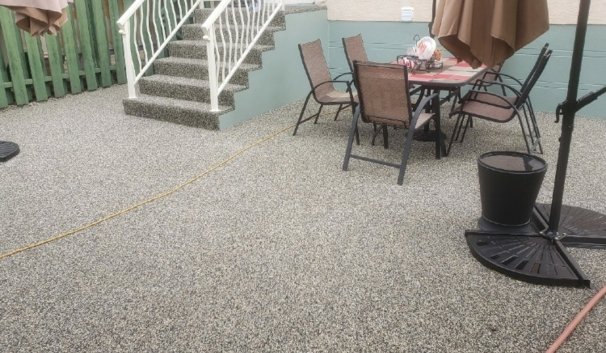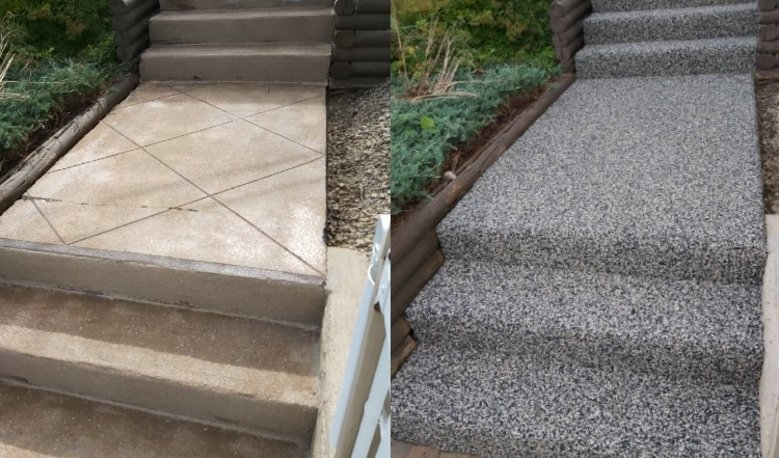Rubber vs Concrete


Comparing the Pros and Cons of Rubber Resurfacing to Concrete Resurfacing
Pour-in-place rubber resurfacing applies a liquid rubber mixture over existing surfaces. It creates a durable, seamless layer that's slip-resistant and weatherproof. It's commonly used in playgrounds, pool decks, and sports surfaces.
Concrete resurfacing involves applying a new layer of concrete over existing surfaces. It enhances durability and appearance without replacing the entire concrete structure.
Cost Comparison
Initial Cost: When comparing the initial cost of rubber resurfacing to concrete resurfacing, rubber resurfacing often has a higher upfront cost due to the specialized materials involved. Concrete resurfacing, on the other hand, generally has lower initial costs as it utilizes traditional concrete materials that are widely available.
Long-Term Cost: In terms of long-term cost comparison, rubber resurfacing tends to have advantages over concrete resurfacing.
Rubber surfaces are known for their durability and low maintenance requirements, reducing the need for frequent repairs or replacements. They are resistant to cracking, chipping, and fading, resulting in potential cost savings over time. Additionally, rubber resurfacing often requires minimal maintenance, such as occasional cleaning, sealing, or reapplication, which can be done at a relatively low cost.
In contrast, concrete surfaces may require more maintenance and repairs over their lifespan, which can lead to increased long-term costs. While concrete resurfacing may have lower upfront costs, the durability and low maintenance of rubber resurfacing can make it a more cost-effective choice in the long run.
Durability and Lifespan
Rubber resurfacing is known for its excellent durability, offering resistance to cracking, chipping, and impact absorption. It can withstand heavy foot traffic and is often more forgiving in harsh weather conditions. The lifespan of rubber resurfacing can vary but is generally considered to be long-lasting, up to 15 years or more.
On the other hand, concrete resurfacing also provides durability, but it may be more prone to cracking and chipping over time, especially in Canada where we have severe freeze-thaw cycles. However, the lifespan of concrete resurfacing can be extended with proper maintenance and sealants.
In terms of overall durability and lifespan, rubber resurfacing tends to have an edge over concrete resurfacing due to its ability to withstand impact and adapt to various weather conditions.
Rubber Stone Maintenance: Rubber resurfacing generally has lower maintenance needs. Rubber surfaces are typically non-porous, making them resistant to stains and requiring minimal cleaning. Routine maintenance may involve periodic cleaning with a simple pressure washer, mild soap, and water to remove dirt or debris. Resealing or reapplication of a topcoat is necessary every 4-5 years to maintain the surface's appearance and durability.
Concrete Maintenance: In contrast, concrete resurfacing may require more maintenance. Concrete surfaces are porous and can be susceptible to staining, requiring regular cleaning and sealing to protect against moisture and staining agents. Depending on the specific conditions and usage, concrete resurfacing may need more frequent sealing, repairs of cracks or chipped areas, and periodic reapplication of protective coatings.
Overall, rubber resurfacing generally offers lower maintenance requirements compared to concrete resurfacing, making it a convenient and hassle-free option for long-term surface upkeep.
Customization
When it comes to customization options, both rubber resurfacing and concrete resurfacing offer various possibilities:
Rubber Resurfacing:
- Colors: Rubber resurfacing allows for a wide range of color choices, allowing you to create vibrant or subtle surfaces.
- Patterns: Rubber resurfacing can be customized with patterns, logos, or designs to personalize the surface. See our photo gallery.
Concrete Resurfacing:
- Decorative Finishes: Concrete resurfacing provides options for decorative finishes like stamped concrete, stenciled patterns, or exposed aggregates, adding visual appeal to the surface.
- Color Stains: Concrete surfaces can be stained or dyed in various colors, allowing for a customized appearance.
- Patterns and Borders: Concrete resurfacing offers the ability to create intricate patterns, borders, or even replicate the look of natural stone or tile.
Both rubber resurfacing and concrete resurfacing allow for customization, but the specific options may vary. Rubber resurfacing offers flexibility in color and pattern choices, while concrete resurfacing provides versatility in decorative finishes, color stains, and pattern replication. The choice between the two would depend on the desired aesthetic and the specific customization options that align with your preferences.
Environmental Impact
When comparing the environmental impact of rubber resurfacing to concrete resurfacing, several factors come into play:
Rubber Resurfacing:
- Eco-friendly Materials: Rubber resurfacing often utilizes recycled rubber materials, such as from tires, reducing waste and promoting sustainability.
- Reduced Carbon Footprint: By reusing rubber materials, the production of new materials is minimized, leading to a lower carbon footprint compared to concrete resurfacing.
- Drainage and Permeability: Rubber resurfacing is typically non-porous, which can limit water runoff and contribute to better stormwater management.
Concrete Resurfacing:
- Resource Consumption: Concrete resurfacing requires new concrete materials, which necessitate the extraction of natural resources like aggregates and cement.
- Energy Intensive Production: The production of concrete involves energy-intensive processes, such as quarrying, transportation, and cement production, which contribute to carbon emissions.
- Landfill Waste: Demolishing existing concrete surfaces during concrete resurfacing can generate significant waste, which may end up in landfills.
In terms of environmental impact, rubber resurfacing has the potential to be more environmentally friendly due to its use of recycled materials and lower carbon footprint. Concrete resurfacing, on the other hand, has higher resource consumption and energy requirements. However, it's worth noting that both options can have varying degrees of environmental impact depending on factors such as transportation distances, waste management practices, and the specific manufacturing processes employed.
HOURS
Mon to Sat
Sunday
8AM - 6PM
Closed
